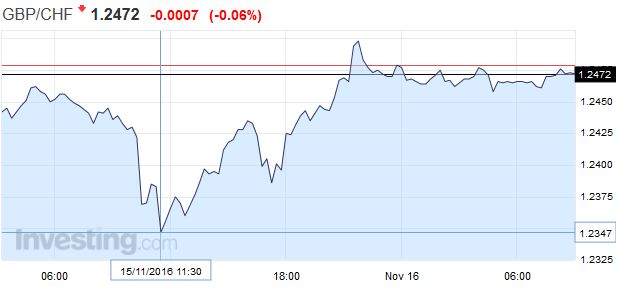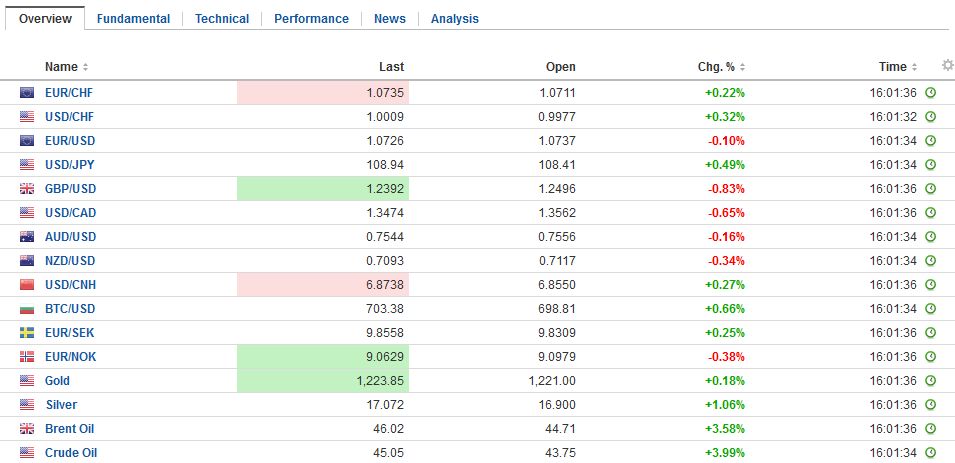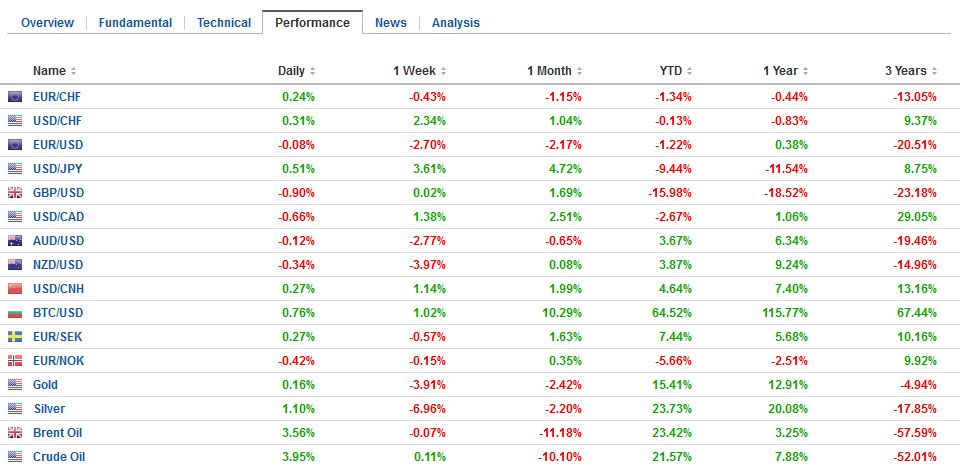Swiss Franc |
EUR/CHF - Euro Swiss Franc, November 15(see more posts on EUR/CHF, ) |
|
The pound took substantial losses against the Swiss Franc and every major currency this morning before recovering in afternoon trade. The leaked government report this morning caused sterling to fall by over 1% against most currencies but it turns out it did not come from a credible source and not from anyone who has met Prime Minister Theresa May. The newspapers which published this should really be putting out the correct information as this would have cost some clients a lot of money. A £200,000 transfer from pounds into Swiss Francs would have generated CHF2500 less today when compared to yesterday as a direct result of the report. The Swiss Franc continues to remain a safe haven currency after the Trump victory last week but the dust is now starting to settle and the markets appear to be taking the trump victory in their stride. After all the recent volatility the Swiss Franc has started to weaken against both the pound and dollar. GBP CHF is now up almost 5 cents from the lows just two weeks ago which is welcome news for sterling exchange rates. Unemployment data for the UK is released tomorrow morning and could actually see a boost for the pound if the headline figure holds steady, or even improves. |
GBP/CHF - British Pound Swiss Franc, November 15(see more posts on GBP/CHF, ) |
FX RatesAfter a dramatic run since the US election, the capital markets are consolidating today. It is a bit too restrained to such a Turn Around Tuesday is unfolding. The euro is struggling to sustain corrective upticks through $1.08, and after a pullback is, the greenback pushed back above the JPY108 level like a beach ball held under water. In fairness, the selling pressure on US Treasuries, a key driver in the recent moves, seemed to dissipate yesterday, though the bears made a stand in late-afternoon turnover. The 10-year yield is off six basis points to 2.20%. It reached 2.30% at its peak yesterday. Another market that has born the pressure of the post-US election moves has been emerging market equities. The MSCI Emerging Market equity index is snapping a four-day more than 9% drop. However, its 0.3% gain off four-month lows is indicative of the thus far flattish consolidation after big moves. |
FX Performance, November 15 2016 Movers and Shakers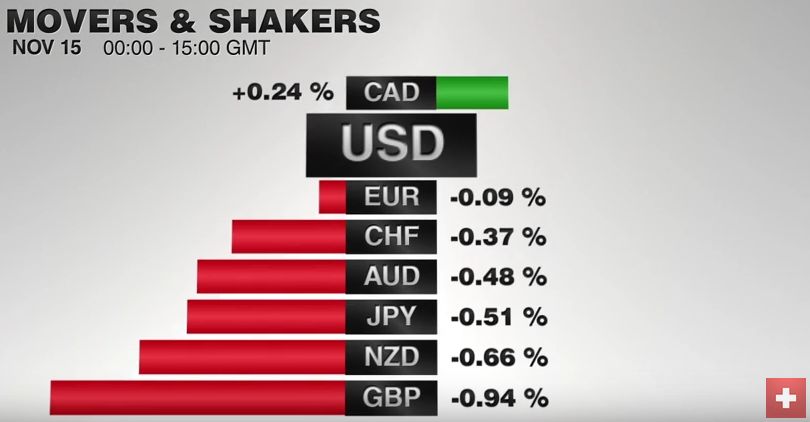 . Source: Dukascopy - Click to enlarge |
| Gold is up around 0.4% from a five-month low. Oil is up nearly 2.2%. Both have fallen almost 4.5% in the past three sessions. On the other hand, the industrial metals, which have rallied strongly, are lower today, including copper, iron ore, and zinc. The recent surge in the Nikkei and Shanghai Composite has also faded with minor losses being reported. As a small aside, the Topix did manage to rise 0.2%, led by the financial sector (~+1.4%) as the three largest banks reported better than expected earnings (despite the negative interest rates). While the MSCI Asia Pacific Index eked out a small gain, the exchanges in Indonesia, Philippines, South Korea and Taiwan all reported net foreign equity sales continued today. |
FX Daily Rates, November 15 (GMT 16:00) |
| There have been several economic reports. The two most interesting developments are that price pressures eased in the UK, despite sterling’s weakness, and Italy’s Q3 GDP rose faster than Germany’s.
The euro has bounced from about $1.0710 yesterday to $1.0815 today in late-Asia. It has straddled the $1.08 level in Europe as if waiting for new directional cues from North American participants. The narrative that is being told about the pullback does not mesh with the shallowness of the price action. Many observers are pointing to the high degree, perhaps higher degree than is usual, of uncertainty surrounding the policies of the Trump Administration, which is still two months away from taking office and even longer from enacting the measures that have driven the markets. |
FX Performance, November 15 |
United KingdomOctober consumer prices in the UK rose 0.1%. The market had looked for a 0.3% increase. This saw the year-over-year rate slip to 0.9% from 1.0%. The core retreated to 1.2% from 1.5%, matching the low of the year, last seen in May. Several MPC member and BOE Governor Carney will be speaking before Parliament today. Although the ONS says, there is little sign that outside of fuel the weaker pound is feeding through to general prices. However, the rise in producer input prices (4.6% a record jump) and output prices (2.1% year-over-year is the largest increase in almost five years) illustrates why some believe there is pressure building. Sterling, which has outperformed recently, as EMU is seen as the next place that populism was taken hold, is under performing today, adding to the consolidative pall. Sterling peaked before the weekend near $1.2675. It slipped briefly below $1.2400 today A break of $1.2350, last week’s low would likely signal that the consolidation is morphing into a correction. |
U.K. Consumer Price Index (CPI) YoY, October 2016(see more posts on U.K. Consumer Price Index, )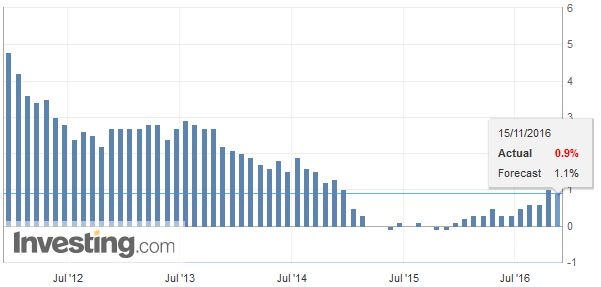 . Source: Investing.com - Click to enlarge |
EurozoneLast week, the EC cut its 2017 GDP forecast to 1.5% from 1.8% estimate issued in May. |
Eurozone Gross Domestic Product (GDP) YoY, October 2016(see more posts on Eurozone Gross Domestic Product, )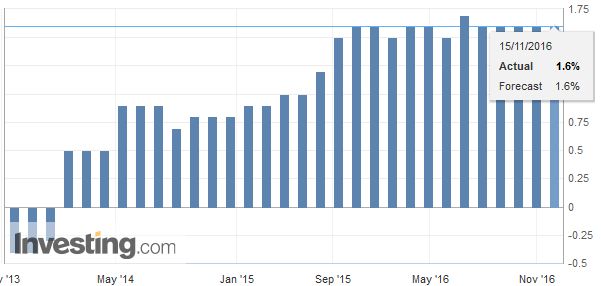 . Source: Investing.com - Click to enlarge |
ItalyItaly surprised with 0.3% Q3 expansion. It follows a flat Q2. Germany disappointed with a 0.2% expansion in Q3. It had expanded by 0.4% in Q2. However, Italy’s quarter ended with poor momentum (industrial output fell 0.8% in September). |
Italy Gross Domestic Product (GDP) YoY, October 2016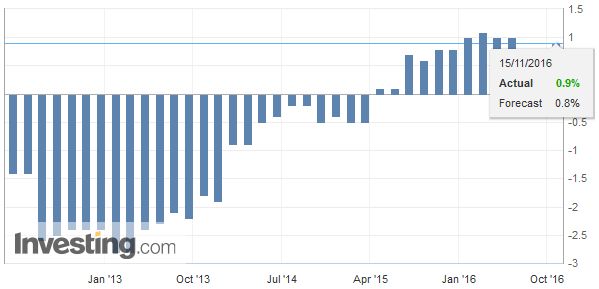 . Source: Investing.com - Click to enlarge |
GermanyGermany, on the other hand, finished with better momentum. Despite the quarterly volatility, the fact is that the German economy has expanded at nearly twice the rate of the Italian economy over the past year (1.7% vs. 0.9%). |
Germany Gross Domestic Product (GDP) YoY, October 2016(see more posts on Germany Gross Domestic Product, )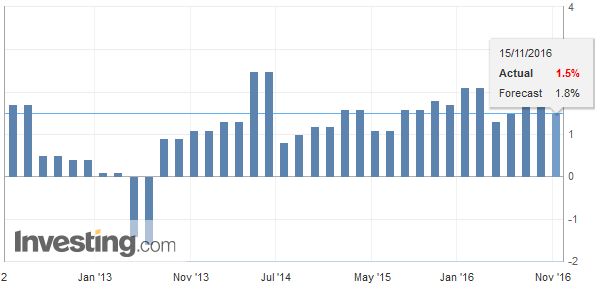 . Source: Investing.com - Click to enlarge |
United StatesThe most important data for the US is the October retail sales report. Retail sales account for about 40% of consumption, which in turn is almost 70% of GDP. After a strong Q2, consumption was tempered in Q2. The GDP component of retail sales excludes autos, gasoline, building materials and a few other good. It rose an uninspiring 0.1% in September. It is expected to rise around 0.4%, which would put the two-month average in line with the longer-term averages. Elsewhere, a surprise on import prices could have implications for tomorrow’s PPI report. |
US Retail Sales and Food Service, ex-Gasoline, October 2016(see more posts on U.S. Retail Sales, ) . Source: macro.ecoblogs - Click to enlarge |
| The Empire State manufacturing survey covers November. It is expected to improve to -2.5 from -6.8. It has not been above zero since July. |
U.S. NY Empire State Manufacturing Index, October 2016(see more posts on U.S. NY Empire State Manufacturing Index, )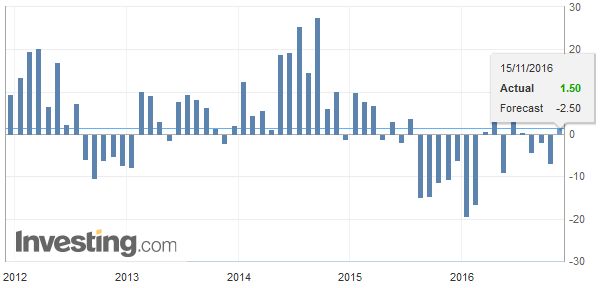 . Source: Investing.com - Click to enlarge |
There is little to fault with that assessment. However, it does not do justice to the shift that has taken place. The markets are anticipatory in nature. They anticipate a reflation policy in the US, but that is not the only driver. They also anticipate the populist wave that is driving the Brexit vote and the Trump victory is going to be expressed in Europe next.
Fed Presidents Lacker and Kaplan yesterday said it was too early for the central bank to respond to whatever shift in fiscal policy is forthcoming. Even before the election, the Fed was signaling another step in its gradual normalization cycle was drawing near. Kaplan and Rosengren speak today, and their views are known. Vice Chairman Fischer spoke before the weekend, and he also reiterated the FOMC stance. Governor Tarullo speaks today as well. He may be the most interesting as he is seen as a potential candidate as one of the “dots” anticipating that no hike this year was appropriate.
Graphs and additional information on Swiss Franc by the snbchf team.
Full story here Are you the author? Previous post See more for Next postTags: #USD,$JPY,EUR/CHF,EUR/GBP,Eurozone Gross Domestic Product,FX Daily,gbp-chf,Germany Gross Domestic Product,Italy Gross Domestic Product,newslettersent,U.K. Consumer Price Index,U.S. NY Empire State Manufacturing Index,U.S. Retail Sales










